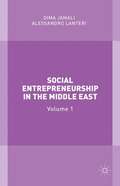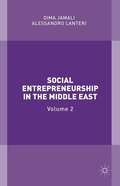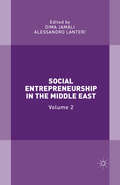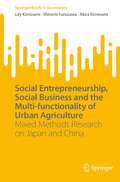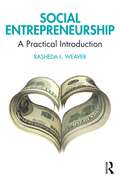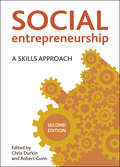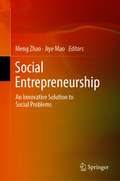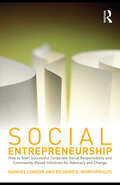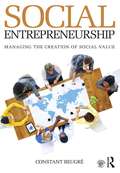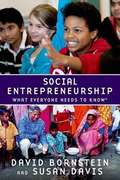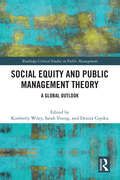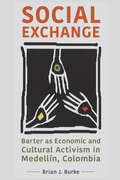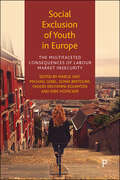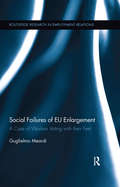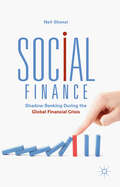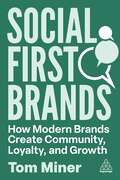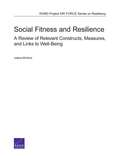- Table View
- List View
Social Entrepreneurship in the Middle East
by Alessandro Lanteri Dima JamaliSocial entrepreneurship has struck a responsive chord in the Middle East. Across the Arab region, we have witnessed the proliferation of social entrepreneurial ventures, designed to address various social ills. Post Arab Spring, the region continues to grapple with a multitude of social challenges that continue to haunt new generations of Arab youth, and turn the spotlight to how to better mobilize and organize social entrepreneurial efforts across the region in support of positive change. In the context of this adversity, Social Entrepreneurship in the Middle East provides an overview of social entrepreneurship in the region, tracing its past, current and potential future trajectory and ensuing implications. This two-volume book unveils trends, strengths, weaknesses and overall dynamics and implications of social entrepreneurship in the Middle East region, whilst identifying both opportunities and threats facing social entrepreneurship and supplements through a wealth of insights and examples inspired from practice and current applications.
Social Entrepreneurship in the Middle East
by Alessandro Lanteri Dima JamaliThis two-volume book unveils trends, strengths, weaknesses and overall dynamics and implications of social entrepreneurship in the Middle East region, whilst identifying both opportunities and threats facing social entrepreneurship and supplements through a wealth of insights and examples inspired from practice and current applications.
Social Entrepreneurship in the Middle East: Volume 2
by Alessandro Lanteri Dima JamaliThis two-volume book unveils trends, strengths, weaknesses and overall dynamics and implications of social entrepreneurship in the Middle East region, whilst identifying both opportunities and threats facing social entrepreneurship and supplements through a wealth of insights and examples inspired from practice and current applications.
Social Entrepreneurship, Social Business and the Multi-functionality of Urban Agriculture: Mixed Methods Research on Japan and China (SpringerBriefs in Economics)
by Lily Kiminami Akira Kiminami Shinichi FuruzawaThis is the first book to clarify the relationships between multi-functions of urban agriculture, creative classes, and social business in China and Japan. Specifically, it constructs a new framework showing how these factors contribute to the sustainability of cities by introducing the mixed methods research of structural equation modeling and the trajectory equifinality model. Policy implications drawn from the research suggests that governments should provide opportunities to create a virtuous cycle to improve the accumulation of social capital in order to attract those who think creatively. It is widely agreed that a sustainable city should meet the needs of the present generation without sacrificing the ability of future generations to meet their own needs. However, there has been no completely agreed-upon definition for what a sustainable city should be nor upon the paradigm for what components should be included. On the other hand, there is a possibility that the multi-functions of urban agriculture may attract especially those who are thinking creatively. These creative thinkers have a high level of social capital, pay attention to social issues, and are greatly motivated to find solutions through social enterprises such as agriculture-related business.
Social Entrepreneurship: A Practical Introduction
by Rasheda L. WeaverSocial Entrepreneurship: A Practical Introduction equips aspiring entrepreneurs with the tools needed to design and launch businesses to create positive social change in their communities. This accessible textbook aims to educate and motivate people interested in social entrepreneurship, showing that such businesses are a valuable part of the community development toolbox. Each chapter focuses on a key aspect of social entrepreneurship, from value creation and business planning to impact measurement and scaling up. Different social business models are presented, with analysis of their strengths and weaknesses. Cases and examples are included throughout the book and showcase real-life social enterprises in North America, South America, Europe, Australia, Africa, and the Caribbean. Discussion questions also support reflection and learning. A downloadable workbook offers support with checklists, social impact measurement, and other areas. An instructor manual containing test questions and experiential exercises is also available as a digital supplement for adopters. This book is ideal for introductory courses in social entrepreneurship and community development. It will also be valuable for those involved in social enterprises on the ground.
Social Entrepreneurship: A Skills Approach
by Christopher Durkin and Robert GunnThe second edition of this popular book has been inspired by the increasing interest around social entrepreneurship scholarship and the practice of delivering innovative solutions to social issues. Although social enterprises generally remain small, the impact of social entrepreneurs is increasing globally, as all countries are endeavouring to respond to increasingly complex social problems and demands for welfare at a time of government cut backs. Additional chapters and international case studies explore new developments, such as the rise of the social investment market, the use of design thinking and the increasing importance of social impact measurement.
Social Entrepreneurship: An Innovative Solution to Social Problems
by Meng Zhao Jiye MaoThis book incorporates theoretical framework and management cases in discussions on social enterprise in China. The authors look to address two fundamental questions about social enterprises in China that have been very controversial over the years. First, what is social enterprise? This book proposes a framework that defines Chinese social enterprises based on social entrepreneurship, and includes ten case studies for justification. Second, who are well-performed social enterprises with financial viability and proved social impact? The book describes in detail some of the leading social enterprises in China. It is aimed at a wide target audience. Practitioners will learn experience and lessons from the case studies. Academics can use the cases in different teaching contexts, and gain research inspirations from our framework and case studies. Policy makers, accreditation agencies, professional service providers, and institutional investors will learn to identify and evaluate promising social enterprises.
Social Entrepreneurship: Building Impact Step by Step
by Teresa ChahineSocial Entrepreneurship provides a 10-stage framework for building impactful ventures within and across new and existing organizations. The book summarizes the basic steps and tools needed to understand a social or environmental challenge of your choice, develop potential solutions, build a business model, measure outcomes, and grow your impact. This fully updated second edition builds on the concepts and tools introduced previously, broadening the scope to those working or preparing to work in organizations globally. Concepts addressed include intrapreneurship and, for the first time, extrapreneurship, which considers innovating across organizations to achieve collective impact. Featuring international case studies and interviews with leaders in the field, this comprehensive guide spans multiple sectors, including health, the environment, education, agriculture, commerce, finance, and retail. Summaries, exercises, and key learning points help to aid and cement learning. A widely regarded and valuable text, Social Entrepreneurship should be core reading for advanced undergraduate and postgraduate students studying entrepreneurship and social entrepreneurship. The book’s applied 10-stage approach will also be valuable for those in executive education as well as professionals and entrepreneurs looking to equip themselves with the tools needed to succeed in social change.
Social Entrepreneurship: How to Start Successful Corporate Social Responsibility and Community-Based Initiatives for Advocacy and Change
by Manuel London Richard G. MorfopoulosWhat motivates someone to become a social entrepreneur? What are the competencies needed to be effective social advocates and agents for change? This book answers these questions in an accessible and practical way, providing comprehensive guidelines, numerous examples, and sources of information and training for anyone who wants to start a community-based social advocacy and change initiative or for employees who want to start a corporate social responsibility initiative. Features include the following: examples of individuals and organizations who have learned from successes and failures in social entrepreneurship self-assessments to help readers evaluate their own talents and proclivity to be social entrepreneurs steps and strategies, competency-building activities, and assessments to evaluate and facilitate initiatives resources available from foundations, government agencies, and other sources for the budding social entrepreneur
Social Entrepreneurship: Managing the Creation of Social Value
by Constant BeugréSocial entrepreneurship differs from traditional forms of entrepreneurship in that the primary goal of the social venture is to address social problems and needs that are as yet unmet. The driving force of such ventures is social value creation. This new textbook aims to provide a comprehensive, cutting edge resource for students, introducing them to the unique concerns and challenges that face social ventures through a comparison with the principles of traditional entrepreneurship. The book consists of fourteen chapters covering all aspects of venture creation and management—from writing a business plan, to financing, people management, marketing, and social impact measurement. Social Entrepreneurship uses real-life examples and sources to expose students to contemporary developments in the field, encouraging them to think critically about the issues faced by social ventures across the globe, and experiential exercises and assignments are included to provide students with hands-on experience in creating and managing their own social ventures. Also containing review and application questions, illustrative cases, definitions of key terms, and a comprehensive companion website, Social Entrepreneurship is the essential guide to this rapidly emerging field. Visit the companion website at www.routledge.com/cw/beugre to find: For Instructors PowerPoint slides, Instructor's manual, Multiple-choice questions. For Students Extra illustrative cases, Web links, Links to video.
Social Entrepreneurship: What Everyone Needs to Know
by David Bornstein Susan DavisOffering a first general overview of social entrepreneurship, it explains what social entrepreneurs are, how their organizations function, what challenges they face and an understanding of what differentiates social entrepreneurship from standard business ventures.
Social Equity and Public Administration: Origins, Developments, and Applications
by H George FredericksonThis book is designed to be the definitive statement on social equity theory and practice in public administration. Social equity is often referred to as the "third pillar" in PA, after efficiency and economy. It concerns itself with the fairness of the organization, its management, and its delivery of public services. H. George Frederickson is widely recognized as the originator of the concept and the person most associated with its development and application. The book's introduction and chapters 1-4 offer general descriptions of social equity in terms of its arguments and claims in changing political, economic, and social circumstances, and trace the development of the concept over the past forty years. Chapters 5-9 provide applications of social equity theory to particular policy arenas such as education, or to specific public administration issues such as the range of administrative discretion, the legal context, the research challenges, and social equity in the context of time and generations. Chapters 10 and 11 describe the current state of social equity and look towards the future.
Social Equity and Public Management Theory: A Global Outlook (ISSN)
by Sarah Young Denita Cepiku Kimberly WileySocial equity is a pillar of public service. Thus, social equity should be a central concern in public management in practice and scholarship. However, widespread incorporation and reflection of social equity practices in government and the anticipated public benefits still seem like an elusive goal. The ability to analytically assess social equity is the first step toward prescribing social equity reforms. Public affairs graduate programs, like a master’s in public administration or public policy, often teach public management separately from social equity. This book empirically and theoretically bridges social equity and public management for use in the public affairs graduate classroom. The book highlights international research that leverages public management theory to build reasonable social equity measures and applications. The research highlighted in the text includes studies from across countries in North and South America, Europe, Southeast Asia, and Australia. This is the first book specifically designed for global public affairs classrooms that connects public management theory and practice with social equity reforms.
Social Exchange: Barter as Economic and Cultural Activism in Medellín, Colombia
by Brian J. BurkeMoney occupies a powerful place in our lives – it is a problem, a goal, and motivator, a measure of self-worth and national progress, and even an influence on how we relate to each other and to nature – but what happens when communities start to reinvent money and markets? Over the last twenty-five years, grassroots activists in Medellín, Colombia, have used barter markets and community currencies as one strategy to re-weave a social fabric shredded by violence and to establish an economy founded on respect and reciprocity rather than exploitation. In Social Exchange, Brian J. Burke provides a deep ethnographic investigation of this activism and its effects. This story draws us into the cultural and material effects of capitalism and narco-violence, while also helping us understand what new radical imaginations look like and how people bring them to life. The result is an intimate glimpse of urban life in Latin America, as well as a broader analysis of non-capitalist or post-capitalist possibility.
Social Exclusion
by Dario Sciulli Giuliana ParodiThe book provides a panoramic approach to social exclusion, with emphasis on structural causes (education, health, accidents) and on short term causes connected with the crisis which started in 2008. The picture emerging, based on econometric analysis, is that the crisis has widened the risk of social exclusion, from the structural groups, like disabled people and formerly convicted people, to other groups, like the young, unemployed, low skilled workers and immigrants, in terms of income, poverty, health, unemployment, transition between occupational statuses, participation, leading to a widening of socio-economic duality. It has also been stressed the relevance of definitions of socio-economic outcomes for the evaluation of the crisis, and their consequences to define interventions to fight socio-economic effects of the economic downturn. The adequacy of welfare policies to cope with social exclusion, especially during a crisis, has been called into question.
Social Exclusion in European Cities: Processes, Experiences and Responses (Regions and Cities #No.23)
by Ali Madanipour Göran Cars Judith AlienAcross Europe concern is rising over the disintegration of social relations and the growing number of people who are being socially excluded. social Exclustoin in European Cities, the first major study of this topic, provides a definition of social exclusion and looks at both the processes which cause it and the dimensions of the problem throughout Europe. The experiences of people living in areas or neighbourhoods with low rates of social integration are considered, illuminating the human impact of exclusion where it is most visible. Finally the contributors evaluate the various policy and community initiatives which are currently confronting the problem in a wide sample of European Cities on a variety of levels, from inform individual actions to supra-national European Union policy, and suggest new ways in which social exclusion could be tackled. With most large cities experiencing some degree of social exclusion, this is an important volume for all those working in the areas of regional policy, town planning, housing management, social work, community development, sociology, political science and urban studies.
Social Exclusion of Youth in Europe: The Multifaceted Consequences of Labour Market Insecurity
by Marge Unt, Michael Gebel, Sonia Bertolini, Vassiliki Deliyanni-Kouimtzi, and Dirk HofäckerEPDF and EPUB available Open Access under CC-BY-NC-ND licence. Policymakers throughout Europe are enacting policies to support youth labour market integration. However, many young people continue to face unemployment, job insecurity, and the subsequent consequences. Adopting a mixed-method and multilevel perspective, this book provides a comprehensive investigation into the multifaceted consequences of social exclusion. Drawing on rich pan-European comparative and quantitative data, and interviews with young people from across Europe, this text gives a platform to the unheard voices of young people. Contributors derive crucial new policy recommendations and offer fresh insights into areas including youth well-being, health, poverty, leaving the parental home, and qualifying for social security.
Social Failures of EU Enlargement: A Case of Workers Voting with their Feet (Routledge Research in Employment Relations)
by Guglielmo MeardiIs the EU enlargement the success EU institutions proclaim? Based on fifteen years of fieldwork research across Central and Eastern Europe and on migrants in the UK and Germany, this book provides a less glittering answer. The EU has betrayed hopes of social cohesion: social regulations have been forgotten, multinationals use threats of relocations, and workers, left without institutional channels to voice their concerns, have reacted by leaving their countries en masse. Yet migration, for many, increases social vulnerability. Drawing on Hirschman’s concepts of ‘Exit’ and ‘Voice’, the book traces the origins of such failures in the management of EU enlargement as a pure economic and market-creating exercise, neglecting the inherently political nature of labour relations. The reinforcement of market mechanisms without political counterbalances has resulted in an increase in opportunistic ‘exit’ behaviour by both employers and employees, and thereby in a worsening quality of democracy, at workplace, national and European levels. As a result of this process, the EU has become more similar to the North American Free Trade Agreement between USA, Canada and Mexico, where social rights are marginalized and economic integration does not translate into better development.
Social Fairness and Economics: Economic Essays in the Spirit of Duncan Foley (Routledge Frontiers of Political Economy #169)
by Lance Taylor Armon Rezai Thomas MichlThis volume brings together papers inspired by the work of Duncan Foley, an extraordinarily productive economist who has made seminal contributions to a wide variety of areas. Foley’s work cannot be easily classified, but one thread that runs through it is a critical examination (along both ethical and analytical lines) of conventional neoclassical economic theory, particularly involving general equilibrium theories of value and money. Foley was a pioneer of complexity economics as well, which adopts approaches to these questions drawn from natural sciences, so the collection therefore has an interdisciplinary quality that will interest a wide variety of readers. Some of the chapters are intellectual biographies that contextualize and identify Foley’s contributions to Keynesian macroeconomics, Marxian value theory, and complexity theory in economics. The topics covered include the economics of complexity; the ethics of general equilibrium theory; the economics of climate change; applications of Keynesian, Marxian and Ricardian political economy; and money and financial crises. The collection should be useful to scholars who work in various economic traditions critical of the currently dominant free-market approach, but it also speaks to scholars of critical theory in various disciplines beyond economics such as the mathematicians, physicists, and other natural scientists who are interested in understanding the complexity of social processes using their analytical frameworks. This book should also appeal to graduate students in economics who are working in these traditions, as well as scholars (including current graduate students in orthodox programs) who are dissatisfied with the current state of economic theory and would like to satisfy their intellectual curiosity by sampling the contributions of critical theorists.
Social Fairness in a Post-Pandemic World: Interdisciplinary Perspectives
by Hikari Ishido Jiro Mizushima Masaya Kobayashi Xiaofang ZhangThis book brings a much-needed re-examination of the concepts of social fairness and justice in light of the COVID-19 crisis. Through careful analysis of issues as diverse as the allocation of vaccines through the global system COVAX, women and gender, migrants and refugees, the environment, and social justice, the authors bring novel perspectives on openness, freedom, and well-being. This ambitious collection combines political, economic, historical, philosophical, and cultural analyses to examine whether it is possible to envision a “fair society” after the global COVID-19 pandemic.
Social Finance and Health (Routledge International Studies in Health Economics)
by Cam Donaldson Neil McHugh Olga BioscaHealth systems across the world face multiple pressures. Input costs are soaring, systems are struggling to keep up with increasing demand for their services and areas of the world still lack universal health coverage. All of this whilst health inequalities between the best and worst-off within countries persist and, in some countries, are even widening. There is a need to think of new initiatives in response to these global health challenges. One such response is social finance. Social finance is about creating social returns. This innovative and rapidly growing sector promotes new ways of banking and funding social and public services. However, social finance has an under-recognised, and potentially underexploited, role in responding to specific aspects of global health challenges: funding and facilitating access to health(care) services and acting on health. The objectives of this book are to conceptualise and evidence different forms of social finance - microfinance and impact bonds - acting in these ways and to critically engage with current debates and challenges. With such evidence to hand, we can either avoid adoption of new trends in financing public services or, more hopefully, attract greater policy support and resources for new tools for public health and in supporting more precarious, but potentially essential, parts of the finance sector. This book will be essential reading to students, researchers, policymakers and the general public alike who are interested in, or who work in, and across, health systems and social finance.
Social Finance, Inc.
by Shawn Cole Rawia Abdel Samad Matt Berner Raluca DragusanuSocial Finance attempts to design and launch a complex new financial instrument that will entice private capital to invest in social service provision.
Social Finance: Shadow Banking During the Global Financial Crisis
by Neil ShenaiThis book presents a new, inter-disciplinary framework of financial instability that builds on the Post-Keynesian model of financial crises in the tradition of Hyman Minsky and Charles Kindleberger. It reincorporates John Maynard Keynes’ insights on economic conventions to explain how market participants construct stable (but fragile) markets and why financial crises tend to take us by surprise. It borrows from scholarship on crises in international relations theory to examine how defied expectations can trigger panics in fragile financial systems. And it draws on perspectives from international political economy to show how elites’ foundational economic beliefs drive their responses to crises and how the effectiveness of their interventions depends on their credibility with the marketplace. The results of interviews with some of the world’s leading investors in Los Angeles, London, New York, and Toronto illustrate the utility of this new paradigm via a case study of shadow banking during the global financial crisis. A close examination of primary and secondary sources and quantitative evidence complement these first-hand accounts. All told, this book’s model offers a viable heuristic device for thinking about financial instability, which will be relevant to academics, policy makers, portfolio managers, and students.
Social First Brands: How Modern Brands Create Community, Loyalty, and Growth
by Tom MinerAs platforms come and go, features fall in and out of fashion and consumer preferences change, brands need to understand how to build social media strategies that transcend trends and create genuine connection. In Social First Brands, expert Tom Miner explores how brands who put their social media front and center in their marketing efforts are reaping the benefits, building genuine communities with their customers and developing true brand loyalty. With many brands seeing social media solely as a way to mass promote their products, brands who really put social at the front and center are able to connect with consumers in authentic ways creating audience empathy and emotional resonance. By understanding how social media speaks to human behavior, brands who put social first are able to move beyond quick wins and hacks and create genuine connections and conversations between brand and customer delivering real value. From understanding the steps for creating a social media strategy that is bespoke, choosing and developing the right personality for your brand on social media or understanding how to create content that is consistent, this book covers everything you need to know to ensure your brand's socials generate loyal fans. With real-world examples from companies such as Crocs, Stanley, Funko and Ryanair, use this book to ensure your social media strategy creates real impact.
Social Fitness and Resilience: A Review of Relevant Constructs, Measures, and Links to Well-Being
by Juliana McgeneOne of a series of reports designed to support Air Force leadership in promoting resilience among Airmen, its civilian employees, and Air Force family members, this report examines social fitness, or the combination of resources from social connections that influence how individuals respond to stressful circumstances. It assesses the current social fitness constructs and measures in scientific literature to identify methods of increasing social connectedness and support among U. S. Airmen and their families.
